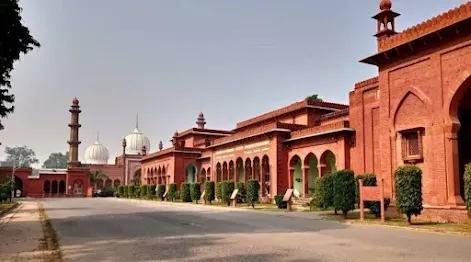Aligarh Muslim University (AMU) is not just an academic institution—it’s a cultural and historical landmark in India’s educational landscape. Founded during a time of intellectual awakening and political upheaval, AMU has evolved from a bold vision of modernist reform to a globally recognized center of learning.
Here’s a detailed overview of AMU: its origins, academic structure, campus life, and ongoing relevance in contemporary India.
1. Origins: From Movement to Institution
AMU’s roots go back to 1875, when Sir Syed Ahmad Khan established the Mohammedan Anglo-Oriental College in Aligarh, Uttar Pradesh. He envisioned a modern education system for Indian Muslims, integrating Western scientific knowledge with Islamic values. At the time, this was revolutionary. Sir Syed’s goal wasn’t just academic—it was sociopolitical. He believed education was the key to upliftment and representation of Muslims in colonial India.
In 1920, the college was transformed into Aligarh Muslim University. It retained its liberal spirit while expanding its academic horizon and becoming one of the first modern residential universities in the country.
2. Academic Structure and Programs
AMU is a fully residential public central university, funded by the Government of India. It hosts students from across the country and from more than 20 foreign nations, especially the Middle East, South Asia, and Africa.
Faculties and Departments:
AMU is organized into 13 faculties, including:
-
Arts
-
Science
-
Commerce
-
Engineering and Technology
-
Medicine
-
Law
-
Social Sciences
-
Theology
-
Life Sciences
-
Management Studies and Research
Each faculty is divided into several departments offering undergraduate, postgraduate, and doctoral programs.
The Jawaharlal Nehru Medical College (JNMC) and Zakir Husain College of Engineering and Technology are particularly well-known.
Special Centers and Schools:
-
Women’s College and AMU Schools provide foundational and pre-university education.
-
Centre for Advanced Study in History, Interdisciplinary Biotechnology Unit, and Centre for Nanotechnology reflect AMU’s investment in research.
3. Campus and Culture
The AMU campus sprawls over 1,150 acres, blending Mughal-inspired architecture with modern academic infrastructure. Landmarks like the Bab-e-Syed gate, Victoria Gate, and Maulana Azad Library (one of Asia’s largest university libraries) give the campus a distinct character.
Cultural Life:
-
The Students’ Union has historically played a significant role in shaping student leadership.
-
AMU hosts numerous debates, mushairas (poetry symposiums), sports meets, and student-run publications.
-
Urdu, Arabic, and Persian cultural influences remain strong, with the Department of Urdu being among the best in the world.
Diversity and Inclusion:
AMU maintains a unique identity as a minority institution under Article 30 of the Indian Constitution, while also welcoming students from all backgrounds. The blend of modern secular education with an Islamic ethos makes AMU stand out.
4. Alumni and Impact
AMU’s alumni network includes:
-
Dr. Zakir Husain, former President of India
-
Naseeruddin Shah, actor
-
Syed Hamid, educationist and civil servant
-
Arif Mohammad Khan, Governor of Kerala
-
Many civil servants, academics, lawyers, and business leaders
The “Alig” identity carries weight both in India and abroad. AMU’s alumni associations span continents, fostering community and continuity.
5. Contemporary Role and Challenges
AMU continues to be at the heart of conversations around:
-
Minority education and representation
-
Secularism and pluralism in Indian universities
-
Access to higher education for marginalized communities
Like many institutions, AMU faces its share of political scrutiny and funding challenges. However, it remains resilient—backed by its legacy, academic strength, and strong community bonds.
Conclusion: A Living Legacy
Aligarh Muslim University is not merely a place of learning—it’s a space where history, identity, and intellect intersect. From its 19th-century reformist roots to its 21st-century role in global academia, AMU continues to navigate the tension between tradition and progress. It doesn’t just educate minds; it shapes narratives.
For anyone studying education reform, secularism, or Muslim identity in South Asia, AMU offers a powerful case study—one that’s still being written.




.jpeg)

.jpg)









.webp)

0 Comments
* Please Don't Spam Here. All the Comments are Reviewed by Admin